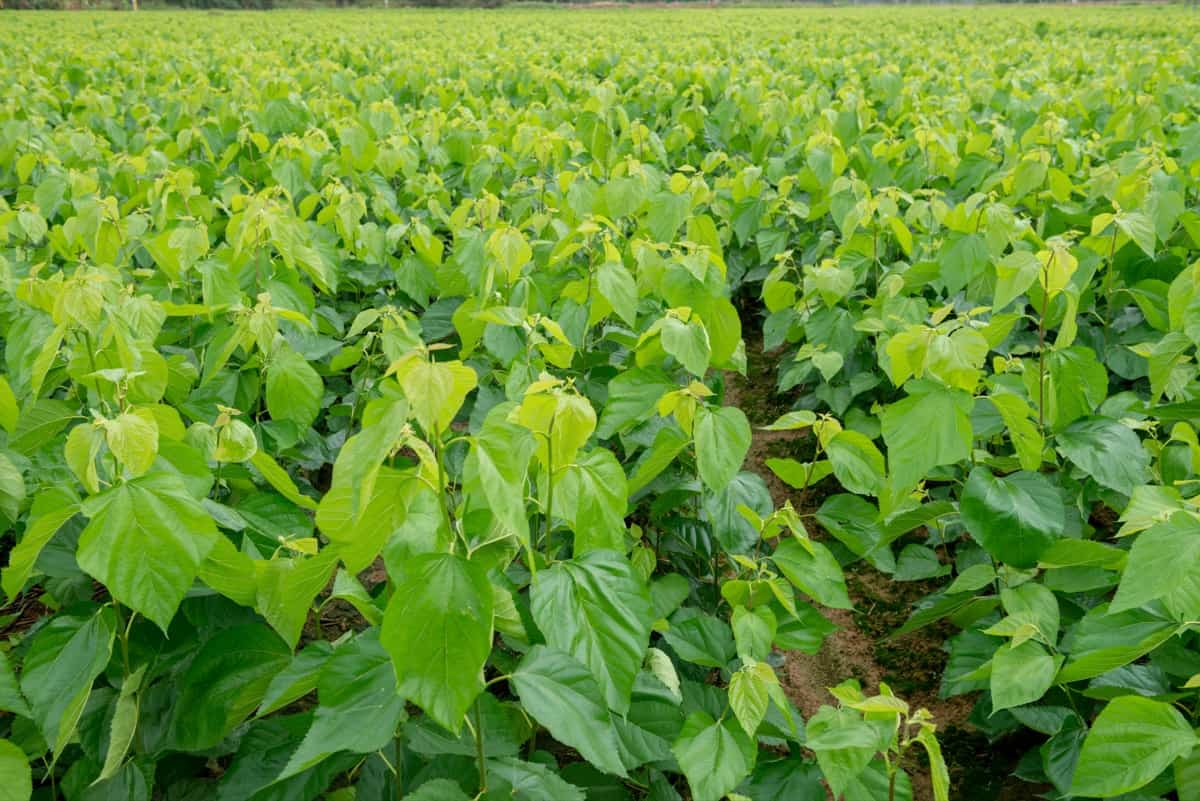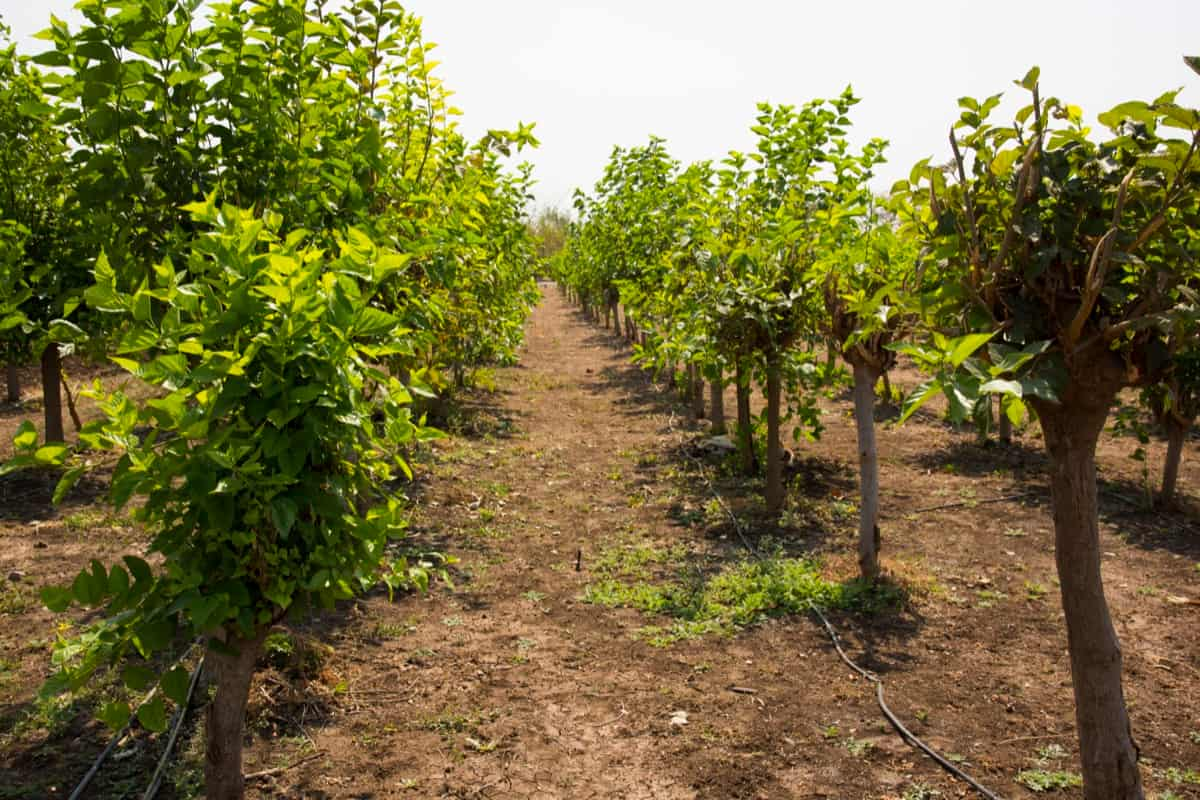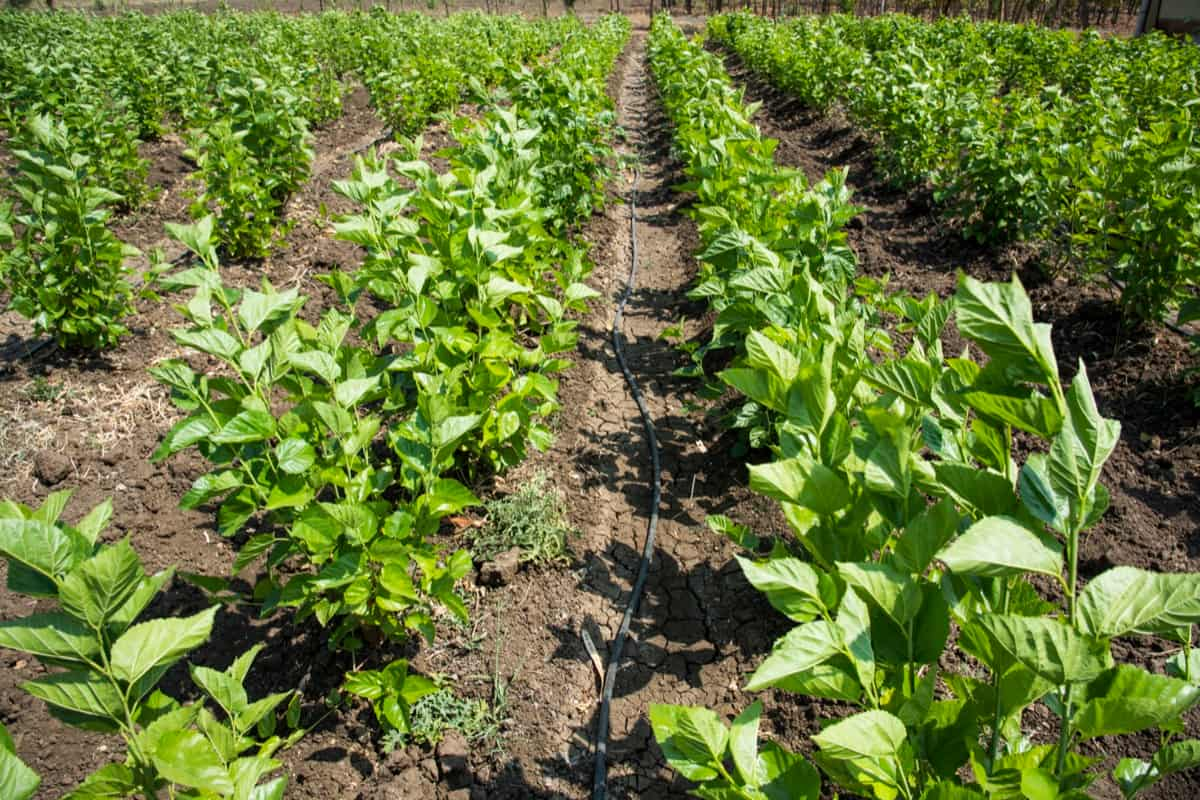Welcome to our blog post on Mulberry Farming in India! India is known for its different culture and heritage, but did you know it is also a significant producer of Mulberry? India’s tropical environment makes it the perfect place for mulberry cultivation.

This article will cover the specifics of Mulberry farming’s Trees Per Acre, Crop Duration, Planting Methods, and Yield. Whether you are an experienced farmer or a beginner, this article will offer helpful ideas and information to advance your Mulberry farming. So relax and get ready to learn more about the exciting industry of Indian Mulberry growing.
Mulberry farming in India
What are Mulberry farming and Moriculture?
Mulberry farming is the cultivation of the Mulberry tree (Morus alba) to harvest its leaves, which are the primary food source for silkworms. The Mulberry tree is grown for the leaves, which are used to feed silkworms in the production of silk. The practice of growing mulberry plants specifically to feed them to silkworms is known as moriculture.
Mulberry plants have an initial output of 12,000 to 15,000 kg of leaves per hectare on nearly 300,000 hectares of farming in India. However, the productivity of this agricultural land has substantially risen thanks to developments in agricultural technology.
Climate, soil, temperature, and rainfall requirements for Mulberry farming
Mulberry trees require a specific climate and soil type for optimum growth. They can be grown up to 800 meters above sea level with ideal temperatures between 24-28°C and relative humidity of 65-80%. The plant requires a rainfall range of 600mm to 2500mm, with supplemental irrigation necessary for low rainfall conditions. Optimal growth occurs in slightly acidic soils with a pH range of 6.2-6.8 and minimal salt content. Alkaline and saline soils are not suitable for mulberry farming.
Popular states of Mulberry farming in India
Mulberry cultivation is practiced in various climates across India. Most of the area is located in the tropical zone in Karnataka, Andhra Pradesh, and Tamil Nadu, accounting for approximately 90% of the total area. In the sub-tropical zone, West Bengal, Himachal Pradesh, and the northeastern states also have a significant area under mulberry cultivation.
In case you missed it: Agriculture Cold Storage Construction Cost: A Complete Guide for Indian Farmers

The state with the largest area under mulberry cultivation is Karnataka, with 166,000 hectares, followed by Andhra Pradesh, with 38,084 hectares. Other states with notable areas under mulberry cultivation include Assam, Jammu & Kashmir, Kerala, Madhya Pradesh, Manipur, Tamil Nadu, Uttar Pradesh, and West Bengal.
Propagation of Mulberry Method: Cuttings
Planting material
- Semi-hardwood cuttings from an established garden of 8-12 months old.
- Cuttings of 15-20 cm with 3-4 active buds and a diameter of 10-12mm.
- Sharp, clean cuts are made at both ends without splitting the bark.
Nursery preparation
- Eight hundred square meters of red loamy soil near a water source.
- Apply Farm Yard Manure (FYM) and thoroughly mix it into the soil.
- Avoid the shaded region by raising nursery beds 4m x 1.5m in size with a drainage canal.
- Cuttings are pre-treated with Azospirillum culture to promote early roots.
Nursery planting
- Apply VAM and irrigate the nursery bed.
- Plant the cuttings at 15 cm x 7 cm spacing at an angle of 45o with one active bud exposed.
- Irrigate the nursery once in three days.
- Dust with malathion or quinalphos to avoid termite attack.
- Drench the soil with carbendazim or apply Trichoderma viride to avoid root rot and collar rot.
- Apply 100 g of urea after 55-60 days of planting during weeding.
Age of saplings: After 90-120 days, saplings are suitable for transplantation onto the main field.
Mulberry planting methods
- There are two main planting methods for mulberry cultivation, the Paired row system and the Pit system.
- The cuttings or saplings are planted in the paired row system at 75cm x 90cm or 105cm x 90cm. The wider inter-row space is used to raise intercrops and is amenable to mechanization. Leaf transport is easy and avoids moisture loss, and Shoot harvesting saves 40% on labor.
- The cuttings or saplings are planted in the pit system at a spacing of 90cm x 90cm. The number of cuttings per hectare for 60cm x 60cm spacing is 27,780, and for 90cm x 90cm spacing is 12,345.
- The best time to plant mulberry cuttings or saplings is during the rainy season. Still, it is advised to avoid planting during the winter and summer months. The well-rooted and sprouted saplings should be planted at a depth of 15-20 cm, and the area around them should be earthed up and leveled. Gap filling can be done during monsoon months.
Fertilizer and manure application in Mulberry farming in India
Farm Yard Manure (FYM) should be applied at a rate of 20 metric tons per hectare per year in two equal doses. For the first year, apply NPK fertilizer at a rate of 350 kilograms of Nitrogen, 140 kilograms of Phosphorus, and 140 kilograms of Potassium per hectare per year, in 5 equal splits. For subsequent years, the NPK fertilizer application rate should be reduced to 300 kilograms of Nitrogen, 120 kilograms of Phosphorus, and 120 kilograms of Potassium per hectare per year, in 5 equal splits.
In case you missed it: Arecanut Profit Per Acre: Cost of Cultivation, Planting Distance, Intercrops, and Yield

Harvesting of Mulberry in India
The harvesting of mulberries for fruit is done when the fruit turns red and is best done in the morning. Two main harvesting methods are hand picking and shaking, with only fully ripe fruits used for processing. The best time to harvest the leaves for silkworms is also in the morning. There are three methods for harvesting the leaves: leaf picking, branch cutting, and whole shoot harvest. The latter involves cutting the branches at ground level, and harvesting shoots every 10-12 weeks, yielding 5 to 6 harvests per year.
Mulberry crop duration
Mulberry is a perennial crop that can reach total yielding capacity in the second year and last for over 15 years without significant yield decline. It thrives best in flat lands with irrigation. The crop duration is over 15 years with proper maintenance.
Number of trees per acre
Different spacing practices are used for irrigated and rain-fed mulberry plantations. For rain-fed Mulberry, the spacing is 5ft x 2.5ft (1.5m x 0.75m), 0.9m x0.9m, while for irrigated Mulberry, it is 4ft x 2.5ft (1.2m x 0.75m). This results in a population of 4,000-5500 trees per acre.
Mulberry yield per acre
The expected annual yield for mulberry leaves is 40-50 tons per acre. The shoot harvest method allows for five harvests every 70 days. The leaf harvest method involves six harvests, with the first taken 70 days after pruning and the following five harvests taken at 55-day intervals.
Conclusion
Mulberry farming in India is a profitable venture with a long crop duration of over 15 years. Several factors influence crop yields, such as planting, irrigation, and proper maintenance practices. Adequate knowledge and proper management practices can result in high yields and long-term profitability in mulberry farming in India.
- Feed Your Flock for Less: Top 10 Tips to Save on Chicken Feed
- Ultimate Guide to Ossabaw Island Hog: Breeding, Raising, Diet, and Care
- Hatching Answers: The Top 10 Reasons Your Chickens Aren’t Laying Eggs
- Eggs and Economics: Breaking Down the Cost of Raising Backyard Chickens
- Defend Your Greens: Proven Methods to Keep Iguanas Out of Your Garden
- Ultimate Guide to Cinnamon Queen Chicken: A Comprehensive Guide for Beginners
- Ultimate Guide to California Tan Chicken: Breeding, Raising, Diet, Egg-Production and Care
- Ultimate Guide to Marsh Daisy Chicken: Breeding, Raising, Diet, and Care
- 10 Types of Chicken Farming Businesses You Can Start for Profits